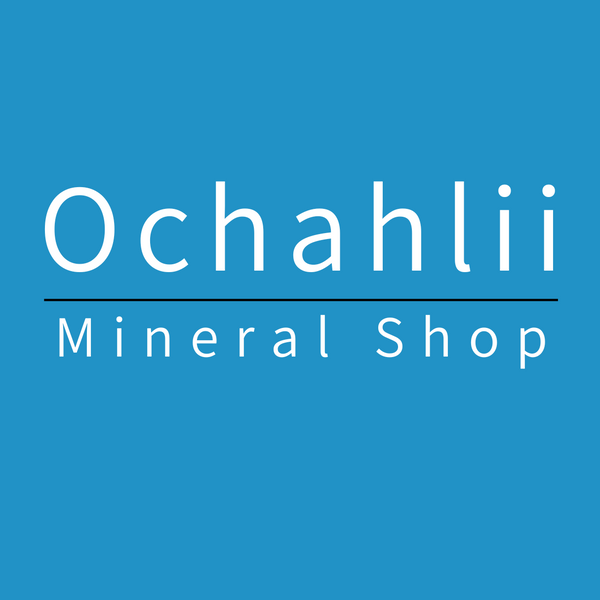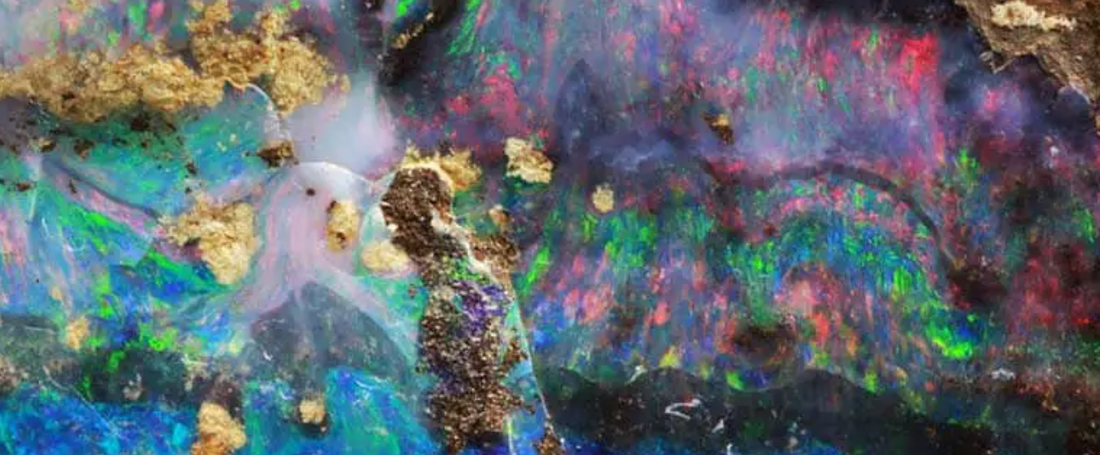
"The Magic of Opals: Care, Types and History Unveiled"
Share
The Magic of Opals:
The history of opal is as colorful and fascinating as the stone itself. Dating back to approximately 4000 BC, opals mark as one of the oldest used gemstones in human history. These early artifacts, believed to have come from Ethiopia, show that the appreciation for opal is deeply rooted in our ancestral cultures.
The Journey of Opal Through the Ages
The way opal, like diamonds, emeralds, rubies and sapphires, was discovered and mined throughout history reflects the development of human civilization. From the careful handiwork of early humans who learned how to carve these gemstones into decorative shapes, to symbolizing wealth within developed communities, opal has held a special place in the annals of history.
Global Appreciation
In the Old World, Hungary was the primary source of opal for Europe and the Middle East, while in the New World Mexico, Peru and Honduras supplied their own empires with this gemstone. The introduction of New World opal to Spain by the conquistadors in the early sixteenth century broadened the horizons of opal as a sought-after treasure.
Australia's Dominance in Opal Production
Since the late 19th century, Australia has dominated opal production, accounting for more than ninety percent of world production. The discovery of opal in Australia and the subsequent development of the fields mark a turning point in the history of opal. The country has become famous for its colorful and rare black and crystal opals, especially from Lightning Ridge.
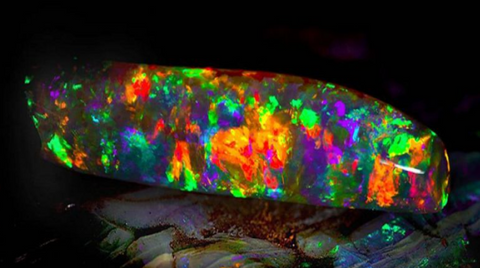
Cultural and Magical Meanings
Opal has been attributed to magical qualities over the centuries. From the early Greeks who believed opal offered powers of foresight and prophecy, to the Romans who saw it as a sign of hope and purity. The stories surrounding opal are rich and varied, such as that of Mark Antony who desired an opal so much that he banished Senator Nonius for refusing to sell his opal, or the Roman emperor who offered a third of his kingdom for just one opal.
Opals are fascinating gemstones, known for their unique ability to refract light and display a brilliant play of colors. Their formation and the diversity of species make opal a special subject of study and admiration.
How Opals Are Created
Opals are formed from a solution of silicon dioxide and water. This happens when rainwater seeps through the earth's surface and dissolves silicon dioxide (SiO2) from sandstone. This silica-rich water then infiltrates deep cracks and cavities in the subsurface. When the water evaporates or drips away, a silica gel is left behind. Over time, sometimes over millions of years, this gel hardens into opal.
Opals usually contain between 6% and 10% water enclosed within their silica structure. This unique structure is responsible for opals' characteristic play of colors, known as opalescence. Light rays passing through the tiny silica particles are refracted and scattered, causing the opal to appear to sparkle in different colors.
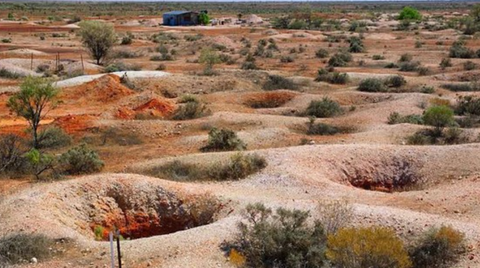
Landscape in Australia where opal is mined (holes to mining tunnels)
Types of Opals
There are many different types of opals, varying in color, origin and value. We list them briefly with their specific characteristics:
- Noble opal : This is the most valuable form of opal, known for its ability to display a full spectrum of colors. Edelopal exhibits a phenomenon known as ' iridescence ' or opalescence, where the stone sparkles and changes color when viewed at different angles. It is formed from a solution of silicon dioxide and water. When the water evaporates, a silicon dioxide precipitate remains that gradually crystallizes into opal. The specific colors observed in an opal's iridescence depend on the size and regular arrangement of the silica particles. Different sizes of silica spheres diffract different wavelengths (colors) of light. Smaller spheres tend towards the blue end of the spectrum, while larger spheres tend towards the red end.
Ethiopian Opal: Found in volcanic rock, mainly in the Welo region, and relatively new to the market since the early 21st century. Ethiopian opal can do both exhibit iridescence effect as a variety of background colors including clear, white, yellow, orange, and even red. Has a relatively high water content, sometimes up to 10% or more, which makes it somewhat sensitive to dehydration and changes in temperature or humidity. This can affect the stability and appearance of the opal over time.
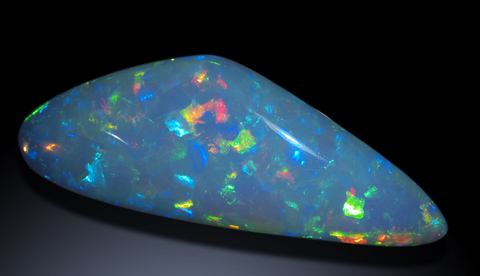
Andamooka opal : A type of precious opal known for its bright colours, native to Andamooka, South Australia. This is one of the oldest known opal fields in Australia. One of the most famous opals, known as the "Andamooka Opal" or the "Queen's Opal", was presented to Queen Elizabeth II in 1954 during her first visit to Australia. This opal, weighing over 200 carats, is one of the largest and most beautiful opals ever found and was set in a necklace as a gift from the people of South Australia. It symbolized Australia's rich natural resources and the warmth of its people.

Other Precious Opals: Commonly occur in sedimentary rocks, such as in Australia, which has a long history of opal mining. Australian opals, such as those from Coober Pedy, Lightning Ridge, and Andamooka, are known for their quality and diversity, including the famous black opal:
Black and Crystal Opals : Black opals have a dark background color that enhances opalescence, making the colors appear particularly vibrant. Crystal opals are translucent to translucent and can show a wide range of colors.
- Fire Opal : Named for its fiery orange, yellow and red colors. Fire opals do not always have the characteristic iridescence of precious opals, but they are sought after for their deep, saturated colors. Mexico is a well-known source of high-quality fire opals.

- Boulder opal : These opals are unique because they are still attached to the parent rock, usually a type of ironstone. Boulder opals can display spectacular colors and patterns, often with a dark background that makes the colors even more vibrant.
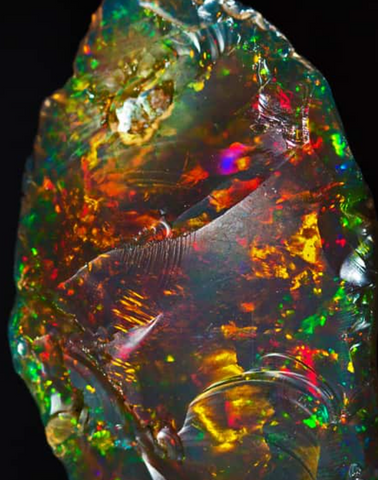
- Harlequin Opal: Characterized by a striking pattern of brightly colored, geometric 'patches', similar to a harlequin costume. This pattern is very rare and sought after. Locations: Australia
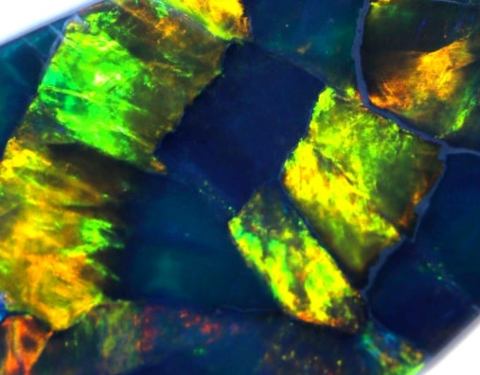
- Milk opals or potch : These are opals that do not show any play of color. They are usually white, gray or green and are often used as a background for boulder poles or in jewelry where the absence of iridescence is desired.`

- Black and Green Opal from Madagascar: Madagascar produces unique varieties of opal, including black and green opals. The black opal often shows a dark background that makes it can enhance the play of color , while the green opal has an attractive green hue without the play-of-color effect. The specific geological conditions of Madagascar, including volcanic activity, contribute to the formation of these opals. L ike other opals, green opal consists of silica and water. The specific conditions under which green opal is formed in Madagascar, such as temperature, pressure and the presence of certain minerals, contribute to the development of its green color.
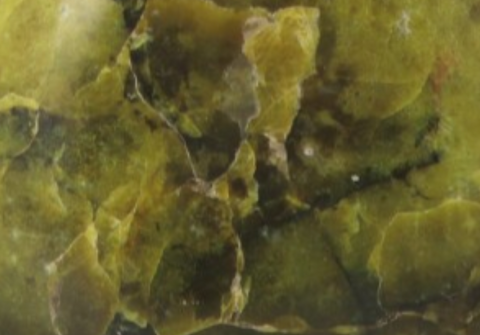
- Opal from Honduras
Honduras is known for its opal with a matricial base, in which the opal is embedded in a dark matrix (mother rock). These opals often do not show the typical iridescent effect but have a unique appeal because of the high-contrast colors against the dark background. Like other opals, Honduran opal forms from a silica solution that precipitates in cracks and cavities of volcanic rock. These opals are sometimes called "black matrix opal" because of the dark matrix in which the opal is embedded.

- Contra-Luz Opal
Unique for its ability to show its iridescence when the light shines through it (contra-luz), unlike most other opals which show its iridescence when the light hits it. Contra-Luz is rare, with some known sites in Mexico and Brazil.
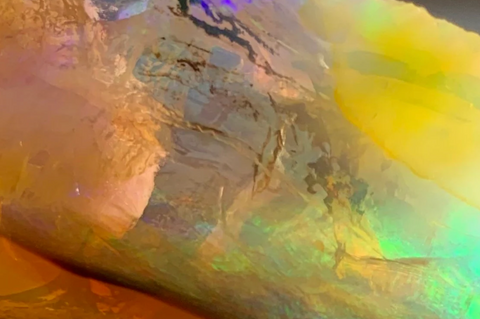
Geographic Distribution
Although opal is found in more than twenty countries, Australia is the largest producer, responsible for approximately 95% of the world's supply. Other countries with notable opal finds include Ethiopia, Mexico, Brazil, and the United States.
The diversity and beauty of opal make it a highly sought after gemstone, both for jewelry and collections. Each piece of opal is unique, with its own individual pattern and color spectrum, adding to the timeless fascination with these beautiful stones.
Care of Opals
- Avoid exposure to extreme temperatures : Opals can dry out due to heat, which can lead to crazing or cracking. Avoid wearing opals in very hot environments or exposing them to direct sunlight for extended periods of time.
- Be careful with water : Although opal is composed of water, prolonged exposure to water, especially when combined with soap or other chemicals, can damage the stone. It is best to remove opal jewelry before showering, swimming or washing hands.
- Avoid shocks and scratches : Opals are relatively soft compared to other gemstones such as diamonds or sapphires. It is important to protect them from hard impacts and scratches by not wearing them during activities that could damage them.
- Gentle Cleaning : Gently clean opals with a damp soft cloth. Do not use ultrasonic cleaners, steam cleaners or harsh chemicals.
Spiritual :
Boulder Opal promotes emotional well-being and helps you release old emotional baggage. It has calming properties that can reduce stress, anxiety and tension, thus creating more inner peace and tranquility. It is a stone that increases intuition. This Opal stimulates creativity and inspiration and helps you express thoughts and feelings in a clear and loving way. It is a protective stone that can ward off negative energies. Boulder opal connects you to the earth and thus promotes stability and balance.
You can find our offer here
